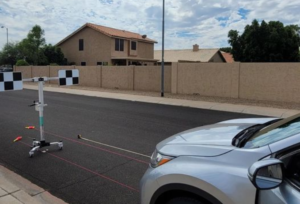Arizona ADAS Calibration Legislation
The state of Arizona recently passed legislation addresses Advanced Drive Assist Systems and the required calibrations associated with them. Here is what the new Arizona law says:
- The auto glass company must inform consumers if a recalibration is required and will be performed on the vehicle, and the auto glass shop must provide an itemized description of the work.
- The auto glass company cannot represent that insurer is paying entire cost unless cost is fully covered as provided by the customer’s insurance policy.
- Recalibration must meet or exceed manufacturer’s specifications.
What Does It Mean To Meet or Exceed Manufacturer’s Specifications

This has been the subject of some debate. Especially in Arizona as the majority of glass shops are having recalibrations done mobile (whether by the shop or a third party contractor) in the middle of the street or in a customer’s driveway. We at Super Clear don’t believe that meets manufacturers specifications. What are some of the issues with calibrating in the middle of the street, given the millimeter accuracy that is required to meet the manufactures specifications?
- Unlevel surface not allowing vehicle or target to be level. (See Flooring Requirements below)
- Uneven lighting or glare that doesn’t allow the car to read the targets accurately. (See lighting requirements below)
- Sunlight can impact how the vehicle’s camera reads the targets. (See Sunlight and Reflective Surfaces below)
- Other objects behind the target can confuse the car and reduce the accuracy of the calibration.
For Super Clear Auto Glass, we want a controlled environment to complete the calibration to the highest level of accuracy possible. If a garage, or light controlled area is not available, we will pick-up the car, bring to our light controlled shop, complete the calibration and deliver your car back to you ready to go. In addition, we drive the vehicle post calibration to ensure that all the features are working the way the manufacturer intended.
Which one would you prefer?
Flooring Requirements: What is the best flooring for an ADAS calibration center?
Popular types of flooring are concrete, epoxy resin, and vinyl. All these materials must be low-gloss/non-reflective and are durable and easy to clean, making them ideal for this type of environment.
Equally important is that every vehicle is on a flat level surface. Many OE manufacturers require floor level within
+/- 10mm. This ensures measurements and calibrations are done accurately. If you’re not able to achieve a level surface, you may need to consider purchasing an integrated alignment rack.
Lighting Requirements: What is the recommended lighting control for ADAS?
Just as important as the space you have is the type of lighting you use. Poor lighting can lead to inaccurate calibration or recalibration, so it’s important your calibration space has adequate illumination. Ideally, your area should have high-quality LED lighting that’s free from flickers and shadows. This will help you achieve accurate results during sensor calibration.
If you’re working in a space with limited lighting, you’ll need to use a light control system that can be set to the appropriate level for your calibration service. It is also crucial to ensure the entire workspace has uniform, diffused lighting. Otherwise, minor elements such as shadows, refractions, or even garage doors could confuse the sensor.
Recommended lighting tips include:
- Adjustable lighting – Seasonality, weather, and time are all factors that influence the way calibration should be done. Having adjustable lighting will help you to account for all these variables and get the most accurate results possible.
- Lighting position – windshield mounted camera calibrations can be sensitive to lighting directly above the camera or hood.
- Light curtains or shades – If you have windows in your workspace, it’s important to use light curtains or shields to minimize glare and reflections. This will help keep the lighting consistent and prevent outside variables from affecting your work.
- A light meter to ensure all points in the shop have a consistent luminance reading.
Sunlight, Reflective Surfaces, and Other Facility Requirements
You’ll also want to consider any other environmental factors that might affect your calibration. For example, if your calibration area is in direct sunlight, you’ll need to make sure the sun doesn’t interfere with the sensors’ readings. Many mobile calibration techs will just saw not to have the vehicle pointing into the sun… really?
Minimizing Reflective Surfaces
Similarly, if there are reflective surfaces in the workspace (such as windows or mirrors), you’ll need to take steps to minimize their impact on the calibration. This might mean using shades to block the reflections or positioning the equipment in a way that avoids them altogether. This includes metal building support posts, metal staircases, tool boxes/ tool benches, and even wall-mounted fire extinguishers.
 This has been the subject of some debate. Especially in Arizona as the majority of glass shops are having recalibrations done mobile (whether by the shop or a third party contractor) in the middle of the street or in a customer’s driveway. We at Super Clear don’t believe that meets manufacturers specifications. What are some of the issues with calibrating in the middle of the street, given the millimeter accuracy that is required to meet the manufactures specifications?
This has been the subject of some debate. Especially in Arizona as the majority of glass shops are having recalibrations done mobile (whether by the shop or a third party contractor) in the middle of the street or in a customer’s driveway. We at Super Clear don’t believe that meets manufacturers specifications. What are some of the issues with calibrating in the middle of the street, given the millimeter accuracy that is required to meet the manufactures specifications?
